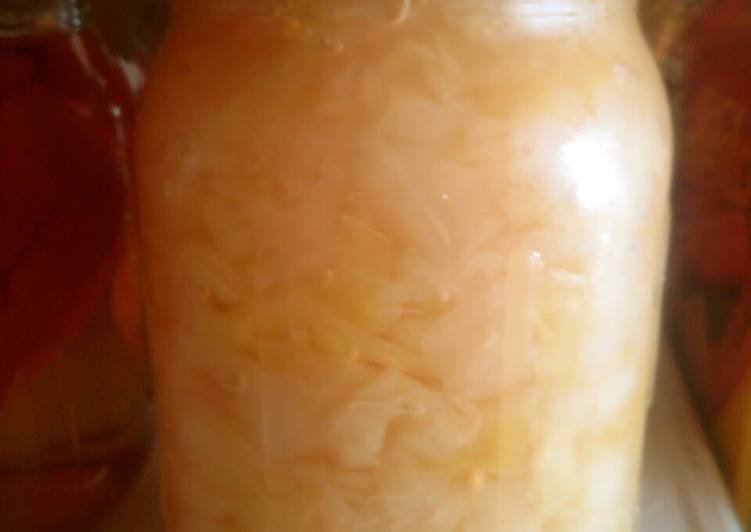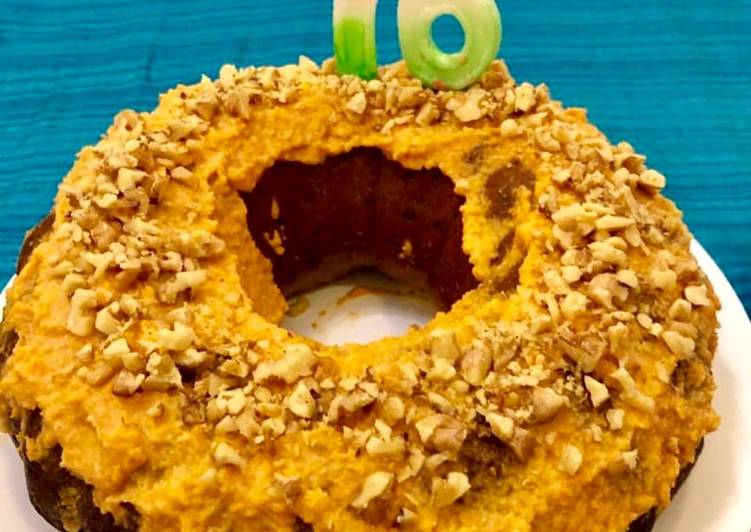
Hey everyone, hope you’re having an amazing day today. Today, we’re going to prepare a instant dish, homemade sauerkraut (no crock required). One of my favorites food recipes. For mine, I will make it a little bit tasty. This is gonna smell and look delicious.
I do it by hand to a coarse chop, but you can use a food processor to shred it fine if you prefer. Put the cabbage in a large non-metal bowl. Sauerkraut has all the benefits of traditional fermented foods, including the abundance of natural probiotics.
Homemade Sauerkraut (no crock required) is one of the most well liked of current trending foods in the world. It is simple, it is fast, it tastes delicious. It is appreciated by millions daily. Homemade Sauerkraut (no crock required) is something that I’ve loved my whole life. They’re fine and they look wonderful.
To get started with this recipe, we have to first prepare a few ingredients. You can cook homemade sauerkraut (no crock required) using 3 ingredients and 18 steps. Here is how you cook that.
The ingredients needed to make Homemade Sauerkraut (no crock required):
- Get 1 cabbage
- Make ready 1 salt
- Make ready 1 mustard seed, optional
And, if something goes wrong, you're only throwing out one jar of sauerkraut, not a whole crock's worth. If you want the salt to work for you, or are feeling lazy and want to put your feet up and sip on a cup of Joe. Is Homemade Sauerkraut Difficult To Make? We have put off making our own sauerkraut until now because we were under the impression that you needed a special crock to ferment the cabbage in, and we were afraid that one batch of sauerkraut would make enough to feed an army for the next year.
Instructions to make Homemade Sauerkraut (no crock required):
- Chop the cabbage. I do it by hand to a coarse chop, but you can use a food processor to shred it fine if you prefer.
- Put the cabbage in a large non-metal bowl.
- Add about 1 tablespoon of canning salt per pound of shredded cabbage.
- Mix the salt and cabbage with your hands for a few minutes, until the cabbage starts to make its own liquid and starts to turn translucent.
- Let the salted cabbage sit for about 30 minutes, then mix again.
- Pack the cabbage into glass jars, pressing it down with a wooden spoon and adding more until it reaches the neck of the jar.
- Make salted water by combining 1 cup of distilled water (I use previously boiled water from the kettle, spring water is also fine) with 1 tablespoon of pickling salt. Stir until the salt is dissolved.
- Pour the salt water over the cabbage mixture to the very top of the jar, and top with a metal canning lid.
- Put the metal ring on the jar loosely. You want water to be able to escape as the cabbage ferments.
- Place the jar(s) in a basin or baking pan with high sides.
- Place the jars somewhere where the temperature is around 65-75 degrees F. They will need to sit here for about two weeks.
- Keep an eye on the jars. As the cabbage ferments, it will start to bubble, pushing liquid out of the jar and into the basin.
- Check the liquid daily. If the level falls below the rim of the jar, add more salt water and replace the lid. Empty the container ever couple of days to avoid attracting fruit flies.
- After about two weeks, you should notice that the water level has stopped dropping.
- Screw on the lids snugly and place the jars in the refrigerator. Once fermented, it will keep for a while (months? I can't say for sure, I've never had it last that long!)
- You can eat the sauerkraut straight out of the jar, or cook it before serving. I usually cook pork chops or bratwurst in the sauerkraut in a cast iron skillet or dutch oven.
- If your sauerkraut is saltier than you like, rinse it before eating.
- Note: A little white mold on the top of your fermenting sauerkraut is harmless – just scrape it away if you see it and top with salted water. You can avoid white mold by being diligent about keeping the water level topped off.
If you have done home canning but no fermenting yet, then the thought of making something even as simple as sauerkraut can be intimidating. Many people — especially conscientious safe home canners — are worried about the idea of deliberately letting bacteria grow in their food. Sauerkraut is finely shredded cabbage that is combined with a brine or massaged to create its own brine, and sometimes herbs and spices. Canned sauerkraut has a very different taste from naturally fermented sauerkraut - the former is quite vinegary, while the latter is tangy and delightfully sour. Making a homemade fermented raw vegan sauerkraut can be much quicker and easier than it may seem.
So that’s going to wrap this up for this awesome food homemade sauerkraut (no crock required) recipe. Thanks so much for your time. I’m confident that you can make this at home. There’s gonna be interesting food in home recipes coming up. Don’t forget to save this page on your browser, and share it to your loved ones, colleague and friends. Thanks again for reading. Go on get cooking!

